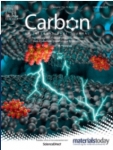Titanium oxide (TiO
2)
nanofibers are interesting for environmental applications, particularly solar energy and water treatment, due to their physical properties, chemical stability, high activity, and strong oxidation capacity. Here, we designed and synthesized halloysite-TiO
2 nanocomposite fibers by combining the electrospinning and sol-gel methods. Halloysite was extracted at Tamra (norther-western part of Tunisia). After optimizing the halloysite and TiO
2 ratio, we characterized the obtained
hybrid materials by
thermogravimetric analysis, X-ray diffraction, scanning and transmission electron microscopy, energy-dispersive X-ray spectroscopy,
Raman spectroscopy, Brunauer-Emmett-Teller method, and X-ray photoelectron spectroscopy. The results confirmed halloysite incorporation into TiO
2 nanofibers. Moreover, when we used these halloysite-TiO
2 nanocomposite nanofibers as
photocatalysts we found that > 91 % of
methylene blue and acetaminophen was removed at neutral pH upon UV and
visible light irradiation. Reusability tests showed good stability over five cycles under visible light. We also carried out
acute toxicity and scavenging tests to monitor the formation of by-products and reactive species during acetaminophen degradation. We found that both O
2•- and h
+ played a major role in its degradation. Overall, halloysite-TiO
2 nanocomposite nanofibers are effective catalysts for the removal of organic dyes and pharmaceutical compounds from water.



